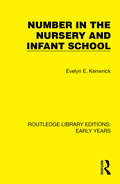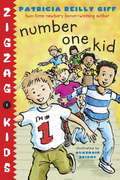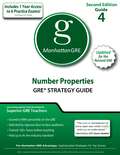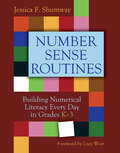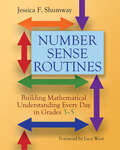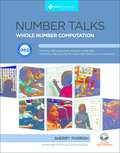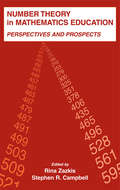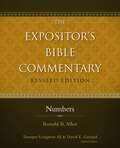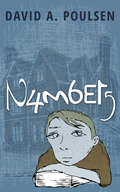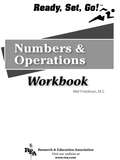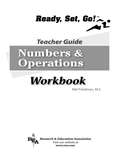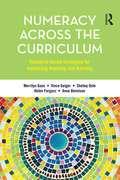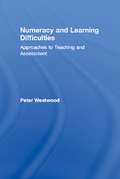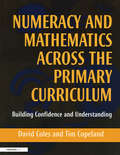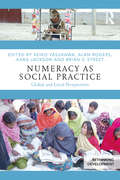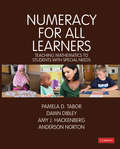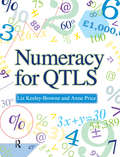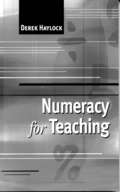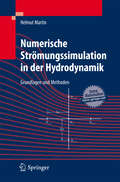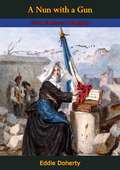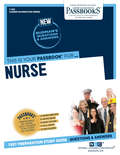- Table View
- List View
Number in the Nursery and Infant School (Routledge Library Editions: Early Years)
by Evelyn E. KenwrickOriginally published in 1937, Number in the Nursery and Infant School surveys the teachings of Froebel, Montessori and Dewey, the prevalent theories in education at the time, and takes elements from each in order to outline a new method. The author was closely associated with infant-school work over a number of years. She also trained teachers for that purpose, carefully observing the results of different methods of teaching. The method described was in full accord with modern psychological theory of the time, today it can be read and enjoyed in its historical context.
Number One Kid
by Patricia Reilly GiffThe author of the beloved Kids of the Polk Street School series introduces a new generation of readers to a multicultural group of kids who enjoy all the activities of an after-school center. I'M #1! That's what Mitchell McCabe's favorite T-shirt says. He'd like to be Number One at the Zigzag Afternoon Center, where there are lots of fun activities to choose from: swimming, nature walks, field trips, art, even homework help. And YAY-there's snack time! But Mitchell is worried. What if he's the only kid who doesn't get a prize on Prize Day? Luckily, Mitchell realizes he's a winner at something terrific. In this delightful new series, award-winning author Patricia Reilly Giff introduces readers to a quirky, lovable group of kids, capturing all the excitement and surprises of new friends and after-school fun. From the Trade Paperback edition.
Number Properties GRE Math Strategy Guide 2nd Edition
by Manhattan Gre StaffUpdated for the revised GRE, the Number Properties Guide provides a comprehensive analysis of the properties and rules of integers tested on the GRE to help you learn, practice, and master everything from prime products to perfect squares. Each chapter builds comprehensive content understanding by providing rules, strategies and in-depth examples of how the GRE tests a given topic and how you can respond accurately and quickly. The Guide contains both "Check Your Skills" questions in the chapters that test your understanding as you go and "In-Action" problems of increasing difficulty, all with detailed answer explanations.
Number Sense Routines: Building Numerical Literacy Every Day in Grades K-3
by Jessica ShumwayIn this groundbreaking and highly practical book,Number Sense Routines: Building Numerical Literacy Every Day in Grades K-3, author Jessica Shumway proposes that all children have innate number sense which can be developed through daily exercise. Shumway createda series of math routines designed to help young students strengthen and build their facility with numbers. These quick 5, 10, or 15 minute exercises are easy to implement as an add-on to any elementary math curriculum. Understanding Number Sense: Students with strong number sense understand numbers, how to subitize, relationships among numbers, and number systems. They make reasonable estimates, compute fluently, use reasoning strategies, and use visual models to solve problems. Number Sense Routines supports the early learner by instilling the importance of daily warm-ups and explains how they benefit developing math minds for long-term learning. Real Classroom Examples: Shumway compiled her classroom observations from around the country. She includes conversations among students who practice number sense routines to illustrate them in action, how children's number sense develops with daily use, and math strategies students learn as they develop their numerical literacy through self-paced practice. Assessment Strategies: Number Sense Routines demonstrates the importance of listening to your students and knowing what to look for. Teachers will gain a deeper understanding of the underlying math skills and strategies students learn as they develop numerical literacy. Shumway writes, As you read, you will step into various classrooms and listen in on students' conversations, which I hope will give you insight into the power of number sense routines and the impact they have on students' number sense development. My hope is that going into the classroom, into students' conversations, and into their thought processes, you will come away with new ideas and tools to use in your own classroom.
Number Sense Routines: Building Mathematical Understanding Every Day in Grades 3-5
by Jessica ShumwayFollowing up her' best-selling book, Number Sense Routines: Building Numerical Literacy Every Day in Grades K-3, Jessica Shumway turns her focus to upper elementary classrooms. Number Sense Routines: Developing Mathematical Understanding Every Day in Grades 3-5 is about tapping into every child' s innate number sense and providing daily, connected experiences that are responsive to children's learning needs. Consistent, Daily Routines Work:' Adaptable to any curriculum, Shumway' s 5, 10, or 15 minute warm-up routines are an easy and effective way to build and solidify students' number sense foundations as a supplement to any program Planning and Facilitating Your Classroom:' No matter how familiar the routine, Shumway provides insight on how to keep daily warm-ups fresh. She reveals careful thinking and planning that goes into each routine and offers detailed vignettes and dialogues of how they unfold in real classrooms Assessment Strategies:' As students engage in the process, each routine becomes an exciting opportunity to gain insight into where they are in their understanding and help students articulate their mathematical thinking Identify Big Ideas: Not only will these math routines help develop students' mathematical understanding as they move towards using standard algorithms, but teachers will learn to better recognize the big ideas that emerge in discussions, how to encourage important strategies based in number sense, and how to facilitate conversations on key mathematical concepts. ' 'These routines may appear in other places, [but] I have never seen them written in such detail and with so many variations.. . .. Although she makes what she does sound easy, we all know that teaching math well is anything but easy. It is challenging and complex. Unpacking what students are saying, helping them make connections not only to the math but to each other's ideas, while simultaneously recording their ideas using mathematical models, visuals, or equations is no easy task. Jessica provides wonderful visuals, examples of student work, and so much more to help educators develop the tools they need to improve their practice and in so doing improve student learning. ' ' ' ' ' ' ' ' ' ' ' ' ' ' ' ' ' ' ' ' ' ' ' ' ' ' ' ' ' ' ' ' ' ' ' ' ' ' ' ' ' ' ' ' ' ' ' ' ' ' ' ' ' ' ' ' ' ' ' ' ' ' ' ' ' ' ' ' ' ' ' ' ' ' ' ' ' ' ' ' ' ' ' ' ' ' ' ' ' ' ' ' ' ' ' ' ' ' ' ' ' ' ' ' ' ' ' ' ' ' ' ' ' ' ' ' ' ' ' ' ' – From the Foreword by math coach and consultant Lucy West
Number Talks, Grades K-5: Helping Children Build Mental Math and Computation Strategies
by Sherry ParrishNumber Talks A five- to fifteen-minute classroom conversation around purposefully crafted computation problems that are solved mentally. The best part of a teacher's day. This dynamic multimedia resource was created in response to the requests of teachers--those who want to implement number talks but are unsure of how to begin and those with experience who want more guidance in crafting purposeful problems. It supports teachers in understanding: what a classroom talk is; how to follow students' thinking and pose the right questions to build understanding; how to prepare for and design purposeful number talks; and how to develop grade-level-specific strategies for the operations of addition, subtraction, multiplication, and division. Number Talks supports the Common Core State Standards for Mathematics.
Number Theory in Mathematics Education: Perspectives and Prospects (Studies in Mathematical Thinking and Learning Series)
by Rina Zazkis Stephen R. CampbellThis book offers multiple interconnected perspectives on the largely untapped potential of elementary number theory for mathematics education: its formal and cognitive nature, its relation to arithmetic and algebra, its accessibility, its utility and intrinsic merits, to name just a few. Its purpose is to promote explication and critical dialogue about these issues within the international mathematics education community. The studies comprise a variety of pedagogical and research orientations by an international group of researchers that, collectively, make a compelling case for the relevance and importance of number theory in mathematics education in both pre K-16 settings and mathematics teacher education.Topics variously engaged include:*understanding particular concepts related to numerical structure and number theory;*elaborating on the historical and psychological relevance of number theory in concept development;*attaining a smooth transition and extension from pattern recognition to formative principles;*appreciating the aesthetics of number structure;*exploring its suitability in terms of making connections leading to aha! insights and reaching toward the learner's affective domain;*reexamining previously constructed knowledge from a novel angle;*investigating connections between technique and theory;*utilizing computers and calculators as pedagogical tools; and*generally illuminating the role number theory concepts could play in developing mathematical knowledge and reasoning in students and teachers.Overall, the chapters of this book highlight number theory-related topics as a stepping-stone from arithmetic toward generalization and algebraic formalism, and as a means for providing intuitively grounded meanings of numbers, variables, functions, and proofs.Number Theory in Mathematics Education: Perspectives and Prospects is of interest to researchers, teacher educators, and students in the field of mathematics education, and is well suited as a text for upper-level mathematics education courses.
Numbers (The Expositor's Bible Commentary)
by Ronald B. AllenContinuing a Gold Medallion Award-winning legacy, the completely revised Expositor's Bible Commentary puts world-class biblical scholarship in your hands.A staple for students, teachers, and pastors worldwide, The Expositor's Bible Commentary (EBC) offers comprehensive yet succinct commentary from scholars committed to the authority of the Holy Scriptures. The EBC uses the New International Version of the Bible, but the contributors work from the original Hebrew and Greek languages and refer to other translations when useful.Each section of the commentary includes:An introduction: background information, a short bibliography, and an outlineAn overview of Scripture to illuminate the big pictureThe complete NIV textExtensive commentaryNotes on textual questions, key words, and conceptsReflections to give expanded thoughts on important issuesThe series features 56 contributors, who:Believe in the divine inspiration, complete trustworthiness, and full authority of the BibleHave demonstrated proficiency in the biblical book that is their specialtyAre committed to the church and the pastoral dimension of biblical interpretationRepresent geographical and denominational diversityUse a balanced and respectful approach toward marked differences of opinionWrite from an evangelical viewpointFor insightful exposition, thoughtful discussion, and ease of use—look no further than The Expositor's Bible Commentary.
Numbers
by David A. Poulsen#1 Calgary Herald Bestseller Just when Andy starts to feel like he finally belongs, can he stand up to the person he trusted the most? Andy Crockett doesn’t fit in at his new school — not with the goths, not with the jocks, and certainly not with the brains. Not even, really, with The Six, a group of misfits who hang out with each other mostly because they can’t stand hanging out with anyone else. But maybe Andy’s luck is changing … and all because he is in Mr. Reztlaff’s grade ten social class — Mr. Retzlaff, the coolest teacher; in fact, the coolest thing about Parkerville Comprehensive. Social is awesome from day one. It’s the class that looks at World War II, Hitler, and the Holocaust. It’s the class Andy wants to ace — and make Mr. Retzlaff proud. But eventually Andy also begins to understand that acing the class might just have a greater cost than he’s willing to pay. And when it turns out that Mr. Retzlaff might not be so cool after all, Andy is facing the most difficult decision of his life.
Numbers and Operations Workbook: Trade Edition (Mathematics Learning And Practice Ser.)
by Mel FriedmanMany students continue to struggle in high school math courses because they failed to master the basic mathematical skills. REA's new Ready, Set, Go! Workbook series takes the confusion out of math, helping students raise their grades and score higher on important exams. What makes REA's workbooks different? For starters, students will actually like using them. Here's why: * Math is explained in simple language, in an easy-to-follow style * The workbooks allow students to learn at their own pace and master the subject * More than 20 lessons break down the material into the basics * Each lesson is fully devoted to a key math concept and includes many step-by-step examples * Paced instruction with drills and quizzes reinforces learning * The innovative "Math Flash" feature offers helpful tips and strategies in each lesson--including advice on common mistakes to avoid * Skill scorecard measures the student's progress and success * Every answer to every question, in every test, is explained in full detail * A final exam is included so students can test what they've learned When students apply the skills they've mastered in our workbooks, they can do better in class, raise their grades, and score higher on the all-important end-of-course, graduation, and exit exams. Some of the math topics covered in the Numbers & Operations Workbook include: * Place values * Rounding * Signed numbers * Fractions * Decimals, fractions, and percentages * Exponents * Order of operations * Integers and more! Whether used in a classroom, for home or self study, or with a tutor, this workbook gets students ready for important math tests and exams, set to take on new challenges, and helps them go forward in their studies!
Numbers and Operations Workbook: Teacher Guide (Mathematics Learning And Practice Ser.)
by Mel FriedmanMany students continue to struggle in high school math courses because they failed to master the basic mathematical skills. REA's new Ready, Set, Go! Workbook series takes the confusion out of math, helping students raise their grades and score higher on important exams. What makes REA's workbooks different? For starters, students will actually like using them. Here's why: * Math is explained in simple language, in an easy-to-follow style * The workbooks allow students to learn at their own pace and master the subject * More than 20 lessons break down the material into the basics * Each lesson is fully devoted to a key math concept and includes many step-by-step examples * Paced instruction with drills and quizzes reinforces learning * The innovative "Math Flash" feature offers helpful tips and strategies in each lesson--including advice on common mistakes to avoid * Skill scorecard measures the student's progress and success * Every answer to every question, in every test, is explained in full detail * A final exam is included so students can test what they've learned When students apply the skills they've mastered in our workbooks, they can do better in class, raise their grades, and score higher on the all-important end-of-course, graduation, and exit exams. Some of the math topics covered in the Numbers & Operations Workbook include: * Place values * Rounding * Signed numbers * Fractions * Decimals, fractions, and percentages * Exponents * Order of operations * Integers and more! Whether used in a classroom, for home or self study, or with a tutor, this workbook gets students ready for important math tests and exams, set to take on new challenges, and helps them go forward in their studies!
Numbers and Stories: Using Children's Literature to Teach Young Children Number Sense
by Ms Rita C. Janes Ms Elizabeth L. StrongCount on children’s books to build number sense! Math and reading go hand in hand, especially among children who are new to both. If you’re looking for a surefire way to build number sense and reading skills at the very same time, rely on this indispensable K-2 resource. Using children’s books as a springboard for learning, it provides 22 ready-to-use lessons—all aligned to the Common Core Standards for Math and ELA. Inside you’ll find 22 interactive, research-based mathematics investigations High-quality children’s book selections Reflection and discussion questions and prompts for both teachers and students Children’s work pages and formative assessment tools An online facilitator’s guide
Numeracy Across the Curriculum: Research-based strategies for enhancing teaching and learning
by Merrilyn Goos Vince Geiger Helen Forgasz Anne Bennison Shelley DoleBeing numerate involves more than mastering basic mathematics. Numeracy connects the mathematics learned at school with out-of-school situations that require capabilities such as problem solving, critical judgment, and sense-making related to non-mathematical contexts. This book provides prospective and practising teachers with practical, research-based strategies for embedding numeracy across the primary and secondary school curriculum. Based on the authors' ten-year research program, the text explains what numeracy is and how numeracy has developed as an educational goal. It describes in detail the five dimensions of the authors' model: attention to real-life contexts; application of mathematical knowledge; use of physical, representational and digital tools; the promotion of positive dispositions towards the use of mathematics to solve problems encountered in day-to-day life; and a critical orientation to interpreting mathematical results and making evidence-based judgements. There is guidance on how to embed numeracy across all subjects within the curriculum, how to assess numeracy learning and how to deal with challenges and dilemmas including working with discipline boundaries and developing support resources.Featuring practical examples and case studies throughout, this book will build pre-service teacher confidence, demystify common misconceptions and grounds theory into practice in this vital area of student competency.'The authors of this text are recognised authorities on numeracy. They have engaged heavily in numeracy research over many years and this text reflects the depth of their understanding and knowledge.' - Geoff Hilton, University of Queensland
Numeracy and Learning Difficulties: Approaches to Teaching and Assessment (Learning Difficulties Ser.)
by Peter WestwoodBy understanding why children struggle with maths, teachers are better equipped to provide effective support and nurture confidence in low-achievers. Numeracy and Learning Difficulties includes how to tackle common learning difficulties by following different teaching practices and principles, identifying gaps in students' knowledge and developing curricula that bridges these gaps, improves numerical literacy using problem-solving strategies and skills, and a handy checklist of benchmarks in achievement.
Numeracy and Mathematics Across the Primary Curriculum: Building Confidence and Understanding
by David Coles Tim CopelandThe key to good primary teaching of numeracy and mathematics is confidence in mathematical knowledge and its relevance to the real world. In particular, effective implementation of the National Numeracy Strategy requires student teachers, primary teachers and mathematics coordinators to realize the place of mathematics across the range of National Curriculum subjects. This book explores mathematics as a set of tools for thinking about, designing, evaluating and changing the world of the child through the broader curriculum, rather than focusing on skills and concept building exclusively in the 'mathematical world.' Practical activities are included to stimulate readers to apply these ideas with confidence both within and beyond the mathematics lesson.
Numeracy as Social Practice: Global and Local Perspectives (Rethinking Development)
by Keiko Yasukawa, Alan Rogers, Kara Jackson and Brian V. StreetLearning takes place both inside and outside of the classroom, embedded in local practices, traditions and interactions. But whereas the importance of social practice is increasingly recognised in literacy education, Numeracy as Social Practice: Global and Local Perspectives is the first book to fully explore these principles in the context of numeracy. The book brings together a wide range of accounts and studies from around the world to build a picture of the challenges and benefits of seeing numeracy as social practice ̶ that is, as mathematical activities embedded in the social, cultural, historical and political contexts in which these activities take place. Drawing on workplace, community and classroom contexts, Numeracy as Social Practice shows how everyday numeracy practices can be used in formal and non-formal maths teaching and how, in turn, classroom teaching can help to validate and strengthen local numeracy practices. At a time when an increasingly transnational approach is taken to education policy making, this book will appeal to development practitioners and researchers, and adult education, mathematics and numeracy teachers, researchers and policy makers around the world.
Numeracy for All Learners: Teaching Mathematics to Students with Special Needs (Math Recovery)
by Pamela D Tabor Anderson Norton Amy J Hackenberg Dawn DibleyNumeracy for All Learners is a wide-ranging overview of how Math Recovery® theory, pedagogy, and tools can be applied meaningfully to special education to support learners with a wide range of educational needs. It builds on the first six books in the Math Recovery series and presents knowledge, resources, and examples for teachers working with students with special needs from Pre-K through secondary school. Key topics include: dyscalculia, what contemporary neuroscience tells us about mathematical learning, and differentiating assessment and instruction effectively to meet the needs of all students in an equitable framework.
Numeracy for All Learners: Teaching Mathematics to Students with Special Needs (Math Recovery)
by Pamela D Tabor Anderson Norton Amy J Hackenberg Dawn DibleyNumeracy for All Learners is a wide-ranging overview of how Math Recovery® theory, pedagogy, and tools can be applied meaningfully to special education to support learners with a wide range of educational needs. It builds on the first six books in the Math Recovery series and presents knowledge, resources, and examples for teachers working with students with special needs from Pre-K through secondary school. Key topics include: dyscalculia, what contemporary neuroscience tells us about mathematical learning, and differentiating assessment and instruction effectively to meet the needs of all students in an equitable framework.
Numeracy for Childcare Students: A Basic Skills Guide
by June GreenFirst Published in 2004. Routledge is an imprint of Taylor & Francis, an informa company.
Numeracy for QTLS: Achieving the Minimum Core
by Liz Keeley-Browne Anne PriceBy 2010 the Government requires all teaching staff in the Lifelong Learning Sector to gain the QTLS (Qualified Teacher Learning and Skills) teaching qualification. In addition to the new qualification, all those training to teach in the post compulsory/FE sector must also have reached an acceptable skill level in literacy, numeracy and ICT before they qualify, this is referred to as 'the minimum core' and states that literacy skills must be equivalent to a level 3 qualification (A Level standard) and numeracy skills must be equivalent to level 2 (GSCE). This aims to be the first core textbook in the market to support those undertaking initial teacher training in the post-compulsory/learning and skills sector (formerly FE). The text is structured in line with the requirements and specifications of the minimum core and therefore guides students to achieve the minimum core and pass the new national tests in order to achieve their QTLS qualification. This is achieved by developing the student's personal knowledge, skills, and strategies in order to ensure that they support their own students when they start teaching/training themselves. In addition a self-audit of numeracy skills is available online in order to identify areas of personal strengths and weakness.
Numeracy for Teaching
by Derek Haylock`Comprises a very helpful resource for students who are obliged to succeed in passing the QTS numeracy test in order to gain QTS. It should provide a valuable resource for students to increase their confidence as well as their competence' - Mathematics in Schools `The stated aim of this book is to help teacher-trainees prepare for the numeracy test all new entrants to the profession now have to pass. Any trainee worried about the test should find this a useful resource.... As in similar books by Derek Haylock, the mathematical content is written in a clear and accessible style' - Mike Askew, Times Educational Supplement Quotes from the author's students `The book is excellent. I think it will present students and others with a valuable resource, not only to help with the QTS test, but also for teaching. I could see myself using it on "dip-in-as-necessary" basis'. `The practice questions were really helpful for checking and consolidating learning. The material was useful for the QTS test, particularly the mental calculations. Many thanks for letting me work through your sample material. I cannot begin to tell you how much more I have learnt! This has definitely made me feel more confident about passing the QTS numeracy skills test! I have definitely demonstrated to myself from this material that my ability to complete calculations mentally has increased. I can calculate faster and with some accuracy now!' `Comprises a very helpful resource for students who are obliged to succeed in passing the QTS numeracy test in order to gain QTS. It should provide a valuable resource for students to increase their confidence as well as their competence' - Mathemtics in Schools This book is designed to help teacher-trainees prepare for the Qualified Teaching Standards numeracy test that must now be passed by all entrants to the teaching profession. The author focuses especially on weaknesses in numeracy often observed in adults, and in teacher-trainees in particular. As far as possible, this mathematics is set in the professional context of teaching, drawing on statistics and other data from individual schools, the DfEE and the Qualifications and Curriculum Agency (QCA).
Numerical Reasoning in Judgments and Decision Making about Health
by Britta L. Anderson Jay SchulkinEvery day thousands of individuals need to make critical decisions about their health based on numerical information, yet recent surveys have found that over half the population of the United States is unable to complete basic math problems. How does this lack of numerical ability (also referred to as low numeracy, quantitative illiteracy or statistical illiteracy) impact healthcare? What can be done to help people with low numeracy skills? Numerical Reasoning in Judgments and Decision Making about Health addresses these questions by examining and explaining the impact of quantitative illiteracy on healthcare and in specific healthcare contexts, and discussing what can be done to reduce these healthcare disparities. This book will be a useful resource for professionals in many health fields including academics, policy makers, physicians and other healthcare providers.
Numerische Strömungssimulation in der Hydrodynamik
by Helmut MartinDer Band liefert eine Einführung in die numerische Strömungssimulation im Bau- und Wasserwesen. Nach einem Überblick über die Methoden werden in Teil 1 Grundlagen und Grundgleichungen der Strömungsmechanik formuliert. In Teil 2 werden ausgewählte Methoden wie die Finite-Element-Methode, das Galerkin-Verfahren, die Finite-Volumen- und Finite-Element-Methode anhand von Beispielen aus der Hydrodynamik erläutert. Vier Programme, mit denen Beispiele im Buch bearbeitet werden können, stehen Lesern unter http://extras.springer.com zur Verfügung.
A Nun with a Gun, Sister Stanislaus: A Biography
by Eddie DohertyTHIS is the story of a rare human being, a dynamo of a woman who devoted her life, joyfully, humorously, expertly, uniquely, to others.Orphaned at 3, brought up by the Sisters of Charity in Nevada, a nun herself at 20, Sister Stanislaus, after several months of nurses’ training in Baltimore, was sent to work in New Orleans. She never really left. Her first, last, and only assignment was Charity Hospital, New Orleans. In time, the two became virtually synonymous.She spent over fifty years there. When she arrived, Charity Hospital comprised one antiquated building; modern medicine was in its swaddling clothes; nursing was an even more hit-or-miss affair. When she left, Charity Hospital was one of the finest in the land and nursing had become a highly professional career.Sister Stanislaus played a large part in the development of both. She brought to nursing a great and joyful zeal, an originality, and a love which affected everyone she came in contact with. Constantly perfecting herself as a nurse, she became one of the best known nursing-sisters in the country.But she did not stop there. Changing, innovating, wheedling money from a string of politicos—from Huey Long and his predecessors by Earl Long—she built Charity Hospital into the great modern institution it is.Yet her fame and her influence were not a result of her public achievement; they were based upon something more immediate, more spiritual. They grew from her all-embracing charity, her lifetime of devotion to the sick and the troubled. She was beloved as a person; the rest, an incredible array of activities and duties, accomplishment and concern, simply happened. Or so she pretended.An extraordinary personality merges from this brisk, expertly written biography, a lively and highly original nun, nurse, and human being, full of surprises but indefatigably on the job, bringing relief and consolation to thousands who passed in and out of a great hospital.
Nurse: Passbooks Study Guide (Career Examination Series #C-534)
by National Learning CorporationThe Nurse Passbook® prepares you for your test by allowing you to take practice exams in the subjects you need to study. It provides hundreds of questions and answers in the areas that will likely be covered on your upcoming exam.
